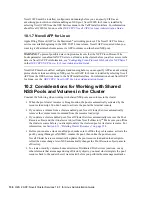
Configuring Cluster Resources for Shared NSS Pools and Volumes
139
no
vd
ocx
(e
n)
7 Ja
nua
ry 201
0
Deselected:
If you want to cluster-enable the pool at a later date, deselect the check box,
then click
Finish
to complete the pool creation process.
To cluster-enable the existing pool, continue by creating a volume on the shared pool as
described in
“Creating NSS Volumes on a Shared Pool” on page 142
, then use the
Clusters
plug-in to iManager to cluster-enable the existing pool as described in
Section 10.5,
“Cluster-Enabling an Existing NSS Pool and Its Volumes,” on page 144
.
10
If you selected
Cluster Enable on Creation
, an additional Cluster Information page appears that
allows you to specify the cluster information.
Specify the following shared pool clustering parameters:
Virtual Server Name:
The name assigned to the virtual server that represents the shared
pool in the cluster.
When you cluster-enable a pool, a virtual Server object is automatically created in Novell
eDirectory and given the name of the Cluster object plus the name of the cluster-enabled
pool. For example, if the cluster name is
cluster1
and the cluster-enabled pool name is
pool1
, then the default virtual server name will be
cluster1_pool1_server
. You can
edit the field to change the default virtual server name.
CIFS Virtual Server Name:
The name (up to 15 characters) assigned to the virtual server
for handling CIFS (Common Internet File System) requests. This is the name of the server
as it appears in a Windows system.
By default, the suggested CIFS virtual server name follows the format of
clustername
_
poolname
_W
. If the name does not comply with the 15-character
maximum length, the default name is shortened by removing characters from the left.
IP Address:
The IP address that you want to assign the virtual server.
To specify an IP address, tab between the different entries; no dot is required in the fields.
For example, if the IP address is
192.168.1.1
, type the following:
192 168 1 1
Advertising Protocols:
Protocols that give users native file access to data.
Select the check boxes of the protocols you want to enable for data requests to this shared
pool.
If Novell CIFS or Novell AFP are not installed and running, selecting the CIFS or AFP
check box has no effect.
NOTE:
For OES 2 Linux and earlier, Novell CIFS and Novell AFP are not available.
CIFS and AFP check boxes can be selected, but CIFS and AFP functionality does not
apply to Linux. Selecting the check boxes has no effect.
AFP:
AFP is the Macintosh networking protocol. Selecting AFP causes commands
to be added to the pool-resource load and unload scripts to activate the AFP protocol
on the cluster. This lets you ensure that the cluster-enabled pool you are creating is
highly available to AFP clients.
CIFS:
CIFS is the Windows networking protocol. Selecting CIFS causes commands
to be added to the pool-resource load and unload scripts to activate the CIFS protocol
on the cluster. This lets you ensure that the cluster-enabled pool you are creating is
highly available to CIFS/Samba clients.
NCP:
NCP is the Novell networking protocol used by the Novell Client. It is
provided by default and is mandatory. Selecting NCP causes commands to be added
to the pool-resource load and unload scripts to activate the NCP protocol on the
















































